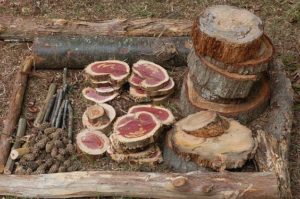When exploring TimberNook of Lancaster County at Climber’s Run, a number of random items might catch your eye…a wood pallet by the creek, a spool in the grass, sheer curtains hanging from a branch, a rain gutter leaning against a tree, and baskets of odds and ends. These items, with nature as their backdrop, begin exciting the imagination almost effortlessly – but why? What’s the thinking behind including these items in the woods? The answer is that what might appear to be “random” items are actually materials for inspiring a child’s creative play, called “loose parts.”
The concept of loose parts came from the British architect, Simon Nicholson, in 1971 to describe “open-ended materials that can be used and manipulated in many ways.” For example, one of our favorite loose parts at TimberNook of Lancaster County will be tree cookies. Tree cookies are small, thin, round tree branch cuttings that may be used as plates to serve friends a pretend meal, stepping stones to an enchanted forest, a delicious doughnut, or a fence for exotic animals. Loose parts spark a child’s imagination and play.
Maybe this is why a young child sometimes finds the gift box of a toy more fun than the toy itself. The box is just more “loose” and without the constraints implied by the toy’s design and function. This type of flexible, limitless imagination play is what we encourage at TimberNook of Lancaster County, and loose parts are a key part of it.
Want to read more on loose parts?
- Loose Parts 2: Inspiring Play with Infants and Toddlers (Loose Parts Series) Paperback – July 12, 2016 by Lisa Daly (Author), Miriam Beloglovsky (Author)
- https://extension.psu.edu/programs/betterkidcare/early-care/tip-pages/all/loose-parts-what-does-this-mean
- http://www.communityplaythings.com/resources/articles/2015/loose-parts


